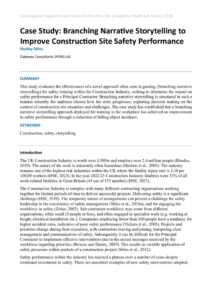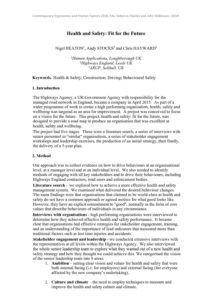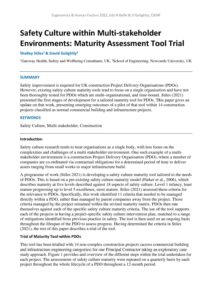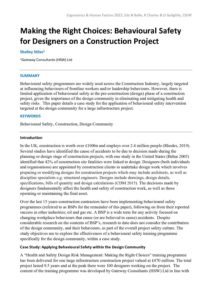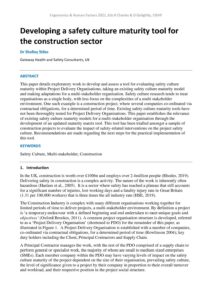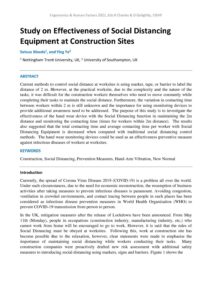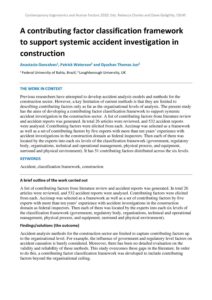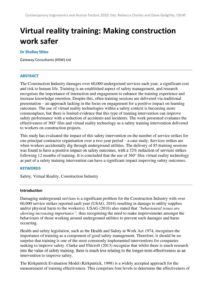Construction
Case Study: Branching Narrative Storytelling to Improve Construction Site Safety Performance
| Document | Author Shelley Stiles |
| Abstract This study evaluates the effectiveness of a novel approach often seen in gaming, (branching narrative storytelling) for safety training within the Construction Industry, seeking to determine the impact on safety performance for a Principal Contractor. Branching narrative storytelling is structured in such a manner whereby the audience choose how the story progresses, exploring decision making on the context of construction site situations and challenges. The case study has established that a branching narrative storytelling approach deployed for training in the workplace has achieved an improvement in safety performance through a reduction of falling object incidents. |
Health and Safety: Fit for the Future
| Document | Author Nigel HEATON, Andy STOCKS and Chris HAYWARD |
| Abstract |
Safety Culture within Multi-stakeholder Environments: Maturity Assessment Tool Trial
| Document | Author Shelley Stiles & David Golightly |
| Abstract Safety improvement is required for UK construction Project Delivery Organisations (PDOs). However, existing safety culture maturity tools tend to focus on a single organisation and have not been thoroughly tested for PDOs which are multi-organisational, and time-bound. Stiles (2021) presented the first stages of development for a tailored maturity tool for PDOs. This paper gives an update on that work, presenting emerging outcomes of a pilot of that tool within 14 construction projects classified as normal commercial building and infrastructure projects. |
Making the Right Choices: Behavioural Safety for Designers on a Construction Project
| Document | Author Shelley Stiles |
| Abstract Behavioural safety programmes are widely used across the Construction Industry, largely targeted at influencing behaviours of frontline workers and/or leadership behaviours. However, there is limited application of behavioural safety at the pre-construction (design) phase of a construction project, given the importance of the design community in eliminating and mitigating health and safety risks. This paper details a case study for the application of behavioural safety intervention targeted at the design community for a large infrastructure project. |
Developing a safety culture maturity tool for the construction sector
| Document | Author Shelley Stiles |
| Abstract This paper details exploratory work to develop and assess a tool for evaluating safety culture maturity within Project Delivery Organisations, taking an existing safety culture maturity model and making adaptations for a multi-stakeholder organisation. Safety culture research tends to treat organisations as a single body, with less focus on the complexities of a multi stakeholder environment. One such example is a construction project, where several companies co-ordinated via contractual obligations, for a determined period of time. Existing safety culture maturity tools have not been thoroughly tested for Project Delivery Organisations. This paper establishes the relevance of existing safety culture maturity models for a multi-stakeholder organisation through the development of an updated maturity matrix tool. This tool has been trialled amongst a sample of construction projects to evaluate the impact of safety-related interventions on the project safety culture. Recommendations are made regarding the next steps for the practical implementation of this tool. |
Safety culture in nuclear power plant construction
| Document | Author Teemu Reiman, Kaupo Viitanen, Jesse Hakala & Karolina Wrona |
| Abstract Safety culture related lessons learned from nuclear power plant construction projects in Finland are presented. A set of questions are proposed for organizations to discuss. The implications of these questions and constraining questions are considered. |
Study on Effectiveness of Social Distancing Equipment at Construction Sites
| Document | Author Setsuo Maeda and Ying Ye |
| Abstract Current methods to control social distance at worksites is using marker, tape, or barrier to label the distance of 2 m. However, at the practical worksite, due to the complexity and the nature of the tasks, it was difficult for the construction workers themselves who need to move constantly while completing their tasks to maintain the social distance. Furthermore, the variation in contacting time between workers within 2 m is still unknown and the importance for using monitoring devices to provide additional awareness need to be addressed. The purpose of this study is to investigate the effectiveness of the hand wear device with the Social Distancing function in maintaining the 2m distance and monitoring the contacting time (times for workers within 2m distance). The results also suggested that the total contacting time and average contacting time per worker with Social Distancing Equipment is decreased when compared with traditional social distancing control methods. The hand wear monitoring devices could be used as an effectiveness preventive measure against infectious diseases of workers at worksites. |
Building a New Hospital: the role of Human Factors
| Document | Author Lauren Morgan, David Higgins & Sue Deakin |
| Abstract The HF approach places all stakeholders at the heart of any project to identify their needs and ensure these are being met, ultimately to optimise efficiency and safety. With regards to building a new hospital, this includes not only patients’ needs, but also those of hospital staff, support workers, volunteers, and patients’ contacts. This paper discusses the approaches taken, and benefits realised |
A contributing factor classification framework to support systemic accident investigation in construction
| Document | Author Anastacio Goncalves, Patrick Waterson and Gyuchan Thomas Jun |
| Abstract Previous researchers have attempted to develop accident analysis models and methods for the construction sector. However, a key limitation of current methods is that they are limited to describing contributing factors only as far as the organisational levels of analysis. The present study has the aims of developing a contributing factor classification framework to support systemic accident investigation in the construction sector. A list of contributing factors from literature review and accident reports was generated. In total 26 articles were reviewed, and 532 accident reports were analysed. Contributing factors were elicited from each. Accimap was selected as a framework as well as a set of contributing factors by five experts with more than ten years’ experience with accident investigations in the construction domain as federal inspectors. Then each of them was located by the experts into each six levels of the classification framework (government, regulatory body, organisations, technical and operational management, physical process, and equipment, surround and physical environment). It has 51 contributing factors distributed across the six levels. |
Towards an Alternative Approach to Safety in Construction
| Document | Author Eleanor HARVEY, Patrick WATERSON and Andrew DAINTY |
| Abstract Many safety-critical industries are moving away from compliance-based safety measures and looking for solutions incorporating adaptability and resilience. However, there are significant challenges when considering applying such measures to construction. The unique design of projects prevents the development of transferable experience, and the use of subcontracting limits opportunities for long-term investment in workers. This paper contrasts the traits of resilient organisations with the characteristics of the construction industry. It is proposed that construction could become more resilient by incorporating employee-level – as opposed organisation-level – aspects of the ‘Adaptive’ age of safety. Further research is needed to understand how the psychological factors believed to underpin a resilient response to risk can be developed. |
Virtual reality training: Making construction work safer
| Document | Author Dr Shelley Stiles |
| Abstract The Construction Industry damages over 60,000 underground services each year, a significant cost and risk to human life. Training is an established aspect of safety management, and research recognises the importance of interaction and engagement to enhance the training experience and increase knowledge retention. Despite this, often training sessions are delivered via traditional presentation – an approach lacking in the focus on engagement for a positive impact on learning outcomes. The use of virtual reality technologies within a safety context is becoming more commonplace, but there is limited evidence that this type of training intervention can improve safety performance with a reduction of accidents and incidents. The work presented evaluates the effectiveness of 360° film and virtual reality technology as a safety training intervention delivered to workers on construction projects. This study has evaluated the impact of this safety intervention on the number of service strikes for one principal contractor organisation over a two-year period – a case study. Services strikes are when workers accidentally dig through underground utilities. The delivery of 85 training sessions was found to have a positive impact on safety outcomes, with a 32% reduction of services strikes following 12 months of training. It is concluded that the use of 360° film virtual reality technology as part of a safety training intervention can have a significant impact improving safety outcomes. |

